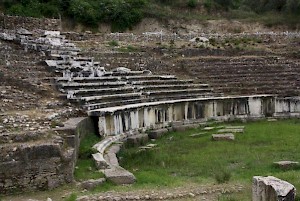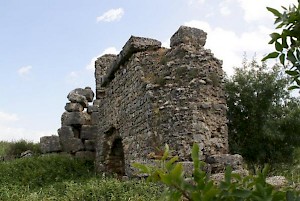Magnesia on the Meander
Q1432674Magnesia on the Meander (Greek Μαγνησία ἐπὶ Μανάνδρου or Μαγνησία ἡ Ἀσιανή, "Asian Magnesia"): ancient city in western Turkey, now Ortaklar.

According to tradition, Magnesia on the Meander was founded at the same time as Magnesia near the Sipylus, both of them settled by soldiers from Agamemnon's army after the Trojan War. These were the only important towns established inland from the Aegean coast at the time of the Hellenic migration to Anatolia at the end of the second millennium BCE.
Although Magnesia on the Meander was in Ionia, its founders were Aeolians and another tradition holds that they went first to Delphi, then to Crete, and then finally crossed the Aegean to Asia Minor. Magnesia was originally located at the confluence of the Meander and the Lethaeus, one of its tributaries, but in 398 BCE it was moved to its present location by Thibron who, at Pergamum, had succeeded Xenophon as commander of the Ten Thousand.

Magnesia was ruled for a time by the Lydian king Gyges (r.680-644) and devastated by the Cimmerians about 650. The Milesians rebuilt the city, but it was captured by the Persians after 547. The Greek researcher Herodotus of Halicarnassus recordsnote that in 522 BCE, Oroetes, the satrap of Lydia, crucified Polycrates, the famous tyrant of Samos, not far from the city of Magnesia.
Later, the Athenian statesman Themistocles settled in Magnesia. His tomb was still visible on the market in the second century CE.

The site possessed a very ancient shrine of the Anatolian fertility goddess, whom the Greeks worshipped here under the name of Artemis Leucophryne (of the White Brow). Late in the third century BCE, the inhabitants of Magnesia on the Meander rebuilt her temple, but the foundations of the original sanctuary can still be seen. The new temple was designed by Hermogenes, who also built the Temple of Dionysus at Teos. The geographer Strabo of Amasia writes that it was the third largest temple in Asia, surpassed only by the sanctuary of Artemis at Ephesus and the temple of Apollo in Didyma.

Magnesia was a very large and important city and the oracle of Apollo at Delphi declared that Magnesia and its environs were sacred ground. This led the Magnetes to institute a great quadrennial festival called the Leucophryna, for which they invited people from all over the Greek world.
On the archaeological site, we can still see the remains of the temple and the altar of Artemis, some remains of the Temple of Zeus Sosipolis, and a Roman basilica. A little bit further on a hill slope lies a well-preserved theatre, and about 700 metres to the north of the site are the remains of a gymnasium. There is also a very big and impressive stadion that could take more than 30,000 spectators.
 Magnesia on the Meander, Temple of Zeus |
 Magnesia on the Meander, Portrait of Agrippa |
 Magnesia on the Meander, Statue of an emperor |
 Magnesia on the Meander, Relief of an officer |
Getting there

The site of Magnesia on the Meander is well signposted at the road near Ortaklar and Söke and the visit is easy.